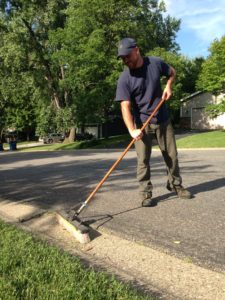Mow High, Sweep Clean
Article by Minnesota Water Steward, Walter L.
Whether you volunteer or follow easy best practices around your home or apartment, you can improve our environment. Several simple lawn care practices provide immediate benefits to our creeks. For example: “mow high and sweep clean” is an easy practice for homeowners and lawn care companies to adopt.
Keep the length of your lawn at three inches when you mow. At a height of three inches, the grass roots are about three inches deep. These longer roots allow the more rainwater to soak into ground. This means less rainwater flowing through stormdrains and into creeks. The remaining water flow is slower and less destructive. A slower flow makes the creek’s water level more stable and reduces damage to creek banks. A lawn with deeper roots also needs less water and is healthier.
 “Sweep clean” means that any grass clippings sent by the mower into your driveway or the street are swept up and put into a compost pile or back onto your lawn. Grass clippings left on the street get flushed to the creek in the next rainstorm. When clippings break down, they release nutrients like phosphorous. Phosphorous helps plants grow: great on your lawn, but not great in lakes. When the clippings break down in our creeks and lakes, the phosphorus feeds algae, creating smelly green scum.
“Sweep clean” means that any grass clippings sent by the mower into your driveway or the street are swept up and put into a compost pile or back onto your lawn. Grass clippings left on the street get flushed to the creek in the next rainstorm. When clippings break down, they release nutrients like phosphorous. Phosphorous helps plants grow: great on your lawn, but not great in lakes. When the clippings break down in our creeks and lakes, the phosphorus feeds algae, creating smelly green scum.
Besides “mow high and sweep clean”, use your sprinkler system wisely. Too much watering saturates the soil, reducing its ability to soak in rain water. When your sprinkler, there is a direct link to energy use. The city must pump and treat water from wells, and this uses high amounts of electricity. So, by following the practices of “mow high and sweep clean”, and avoiding excess irrigation, you can reduce pollution and the use of electricity.
Please adopt these best practices around your home and community to improve water quality. For more information or volunteer opportunities, like the Minnesota Water Stewards program, go to www.ninemilecreek.org/get-involved/volunteer-opportunities/, or minnesotawaterstewards.org/.
